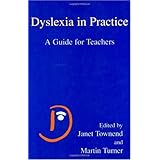
Average Reviews:

(More customer reviews)Are you looking to buy Dyslexia in Practice: A Guide for Teachers? Here is the right place to find the great deals. we can offer discounts of up to 90% on Dyslexia in Practice: A Guide for Teachers. Check out the link below:
>> Click Here to See Compare Prices and Get the Best Offers
Dyslexia in Practice: A Guide for Teachers Review"This book is edited, and significantly contributed to, by two senior members of the staff of The Dyslexia Institute (D.I.)... The work of the D.I. over many years represents an important corpus of practical involvement in identifying and alleviating the varied difficulties experienced by individuals deemed to be dyslexic. The scope of the book and its intended audience are clearly indicated by its title...In this book, one finds many promising practices clearly described. The editors are to be congratulated for undertaking such a difficult but valuable task in what continues to be a controversial field...Townsend's and Turner's book merits the critical attention of educators in general and teachers in particular. It can help those interested and involved in finding, using and developing effective practices for pupils with dyslexia: its use can help in providing some of the expertise required if our schools are to become more "Dyslexia friendly'."Dyslexia in Practice: A Guide for Teachers OverviewDyslexia is a specific learning difficulty that hinders thelearning of literacy skills. This problem with managing verbal codesin memory is neurologically based and tends to run in families. Othersymbolic systems, such as mathematics and musical notation, can alsobe affected. Dyslexia can occur at any level of intellectual ability.It can accompany, but is not a result of, lack of motivation,emotional disturbance, sensory impairment or meagre opportunities. Theeffects of dyslexia can be alleviated by skilled specialist teachingand committed learning. Moreover many dyslexic people have visual andspatial abilities which enable them to be successful in a wide rangeof careers. The appearance of this book .. is to be welcomed. It represents a fullstatement of the best practice to be found in the many kinds ofintervention that are conducted with dyslexic students. It addressessome fundamental questions that are seldom asked and much of what theskilled teacher knows and does is set down here in print for the firsttime. From the Preface: `Collectively, the chapters provide a synthesis of current practicefocusing on how to assess and treat the symptoms of dyslexia, guidedby a proper understanding of the cognitive and linguistic weaknessesthat underpin the condition. The book makes clear that the backbone ofintervention for dyslexia is a highly structured multisensory approachthat teaches reading and spelling skills at the appropriate rate.However, it is also explicit in pointing out that such a programmemust be delivered with due attention to individual differences in theother cognitive skills that contribute to literacy development, andtake account of the learner's style, interests and not least theirconfidence and self-esteem. This book provides an important resource for teachers who wish tobecome competent in the skills required for the assessment, teaching,supporting and counselling of dyslexic people in a variety ofsettings. It promises to reach many teachers and in turn, theirstudents and families'. Margaret J. Snowling, University of York, UKWant to learn more information about Dyslexia in Practice: A Guide for Teachers?
>> Click Here to See All Customer Reviews & Ratings Now
0 comments:
Post a Comment